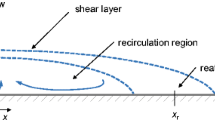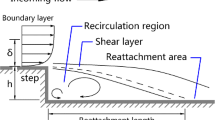Abstract
The flow around a backward-facing step in the sub-, trans- and supersonic regimes was investigated at the Trisonic Wind Tunnel Munich with particle image velocimetry and dynamic pressure measurements. These two techniques were combined to simultaneously measure and correlate the velocity fluctuations in a streamwise vertical plane with the pressure fluctuations on the reattachment surface. The results show that the dynamic loads on the reattachment surface increase from subsonic up to the transonic regime while the mean reattachment location moves downstream. As soon as the flow becomes locally supersonic aft of the backward-facing step, the mean reattachment location suddenly moves upstream while the normalized dynamic loads drastically decrease. By correlating the velocity and the dynamic pressure data, it was shown that a clear separation between outer flow and the flow close to the surface aft of the step is responsible for the drastic load reduction. Due to the large difference in pressure/density, the disturbances from the locally supersonic flow do not have an effect on the flow close to the surface. This is also reflected in the power spectral densities of the pressure fluctuations on the surface, showing that at supersonic free-stream Mach numbers a low-frequency pumping motion of the locally subsonic flow is the dominant mode, while in sub-/transonic flow Kelvin-Helmholtz instabilities and a cross-pumping motion of the shear layer dominate the dynamic loads.















Similar content being viewed by others
References
Statnikov, V., Bolgar, I., Scharnowski, S., Meinke, M., Kähler, C.J., Schröder, W.: Analysis of characteristic wake flow modes on a generic transonic backward-facing step configuration. Eur. J. Mech. B. Fluids 59, 124–134 (2016)
Hannemann, K., Lüdeke, H., Pallegoix, J.-F., Ollivier, A., Lambar, H., Maseland, J.E.J., Geurts, E.G.M., Frey, M., Deck, S., Schrijer, F.F.J., Scarano, F., Schwane, R.: Launcher vehicle base buffeting - recent experimental and numerical investigations. In: Proceedings 7th European symposium on aerothermodynamics for space vehicles , Brugge (2011)
Scharnowski, S., Statnikov, V., Meinke, M., Schröder, W., Kähler, C.J.: Combined experimental and numerical investigation of a transonic space launcher wake. In: Progress in flight physics, vol. 7, pp. 311–328. EDP Sciences (2015)
Eaton, J.K., Johnston, J.P.: A Review of Research on Subsonic Turbulent Flow Reattachment. AIAA J 19, 1093–1100 (1981)
Kuehn, D.M.: Effects of adverse pressure gradient on the incompressible reattaching flow over a Rearward-Facing step. AIAA J 18(6), 343–344 (1980)
Isomoto, K., Honami, S.: The effect of inlet turbulence intensity on the reattachment process over Backward-Facing step. J. Fluid Eng-T ASME 111, 87–92 (1989)
Bernard, N., Sujar-Garrido, P., Bonnet, J.-P., Moreau, E.: Control of the coherent structure dynamics downstream of a backward-facing step by dbd plasma actuator. Int. J. Heat Fluid Flow 61, 158–173 (2016)
Hasan, M.A.Z.: The flow over a backward-facing step under controlled perturbation. J. Fluid Mech. 238, 73–96 (1992)
Ho, C.-M., Huerre, P.: Petrubed free shear layers. Ann. Rev. Fluid Mech. 16, 365–424 (1984)
Eaton, J.K., Johnston, J.P.: Turbulent flow reattachment: an experimental study of the flow and structure behind a backward-facing step. Technical report, Dept. of Mech. Eng. Stanford Univ (1980)
Cherry, N.J., Hillier, R., Latour, M.E.M.P.: Unsteady measurements in a separated and reattaching flow. J. Fluid Mech. 144, 13–46 (1984)
Driver, D.M., Seegmiller, H.L., Marvin, J.G.: Time-dependent behavior of a reattaching shear layer. AIAA J 25(7), 914–919 (1987)
Heenan, A.F., Morrison, J.F.: Passive control of pressure fluctuations generated by separated flow. AIAA J 36(6), 1014–1025 (1998)
Lee, I., Sung, H.J.: Characteristics of wall pressure fluctuations in separated and reattaching flows over a backward-facing step. Exp. Fluids 30, 262–272 (2001)
Scharnowski, S., Bolgar, I., Kähler, C.J.: Control of the recirculation region of a transonic backward-facing step flow using circular lobes. In: 9th Int. Symp. on turbulence and shear flow phenomena (TSFP-9), Melbourne (2015)
Scharnowski, S., Bolgar, I., Kähler, C.J.: Characterization of turbulent structures in a transonic backward-facing step flow. Flow Turbul. Combust (2016)
Barkley, D., Gomes, M.G.M., Henderson, R.D.: Three-dimensional instability in flow over a backward-facing step. J. Fluid Mech. 473, 167–190 (2002)
Beaudoin, J.-F., Cadot, O., Aider, J.-L., Wesfreid, J.E.: Three-dimensional stationary flow over a backward-facing step. Eur. J. Mech. B/Fluids 23(1), 147–155 (2004)
Ginoux, J.J.: Streamwise vortices in reattaching high-speed flows-a suggested approach. AIAA J 9(4), 759–760 (1971)
Statnikov, V., Roidl, B., Meinke, M., Schröder, W.: Analysis of spatio-temporal wake modes of space launchers at transonic flow. In: 54th AIAA aerospace sciences meeting (2016)
Deck, S., Thorigny, P.: Unsteadiness of an axisymmetric separating-reattaching flow: Numerical investigation. Phys. Fluids 19, 065103 (2007)
Halupovich, Y., Natan, B., Rom, J.: Numerical solution of the turbulent supersonic flow over a backward facing step. Fluid Dyn. Res. 24, 251–273 (1999)
Roshko, A., Thomke, G.J.: Observations of turbulent reattachment behind an Axisymmetric downstream-facing step in supersonic flow. AIAA J 4, 975–980 (1966)
de Brederode, V., Bradshaw, P.: Three-Dimensional Flow in Nominally Two-Dimensional Separation Bubbles: Flow Behind a Rearward-Facing Step. Technical Report, Imperial College, London, Great Britain (1972)
Kähler, C.J., Sammler, B., Kompenhans, J.: Generation and control of particle size distributions for optical velocity measurement techniques in fluid mechanics. Exp. Fluids 33, 736–742 (2002)
Scharnowski, S., Kähler, C.J.: On the effect of curved streamlines on the accuracy of PIV vector fields. Exp. Fluids 54, 1435 (2013)
Scharnowski, S., Kähler, C.J.: Estimation and optimization of loss-of-pair uncertainties based on PIV correlation functions. Exp. Fluids 57, 23 (2016)
Mendez, M.A., Raiola, M., Masullo, A., Discetti, S., Ianiro, A., Theunissen, R., Buchlin, J. -M.: POD-Based background removal for particle image velocimetry. Exp. Thermal Fluid Sci. 80, 181–192 (2017)
Avallone, F., Discetti, S., Astarita, T., Cardone, G.: Convergence enhancement of single-pixel PIV with symmetric double correlation. Exp. Fluids 56(4), 1–11 (2015)
Kähler, C.J., Scharnowski, S., Cierpka, C.: On the resolution limit of digital particle image velocimetry. Exp. Fluids 52, 1629–1639 (2012)
Bolgar, I., Scharnowski, S., Kähler, C.J.: Correlations between Turbulent Wall Pressure and Velocity Field Fluctuations in Backward-Facing Step Flows. Deutscher Luft- Und Raumfahrtkongress, Munich. Deutsche Gesellschaft für Luft- und Raumfahrt (2017)
Buchmann, N.A., Kücükosman, Y.C., Ehrenfried, K., Kähler, C.J.: Wall pressure signature in compressible turbulent boundary layers. Progress in Wall Turbulence 2, 93–102 (2016)
Chovet, C., Lippert, M., Foucaut, J.M., Keirsbulck, L.: Dynamical aspects of a backward-facing step flow at large Reynolds numbers. Exp. Fluids 58(11), 162 (2017)
Hudy, L.M., Naguib, A., Humphreys, W.M.: Stochastic estimation of a separated-flow field using wall-pressure-array measurements. Phys. Fluids 19(2), 024103 (2007)
Rodgers, J.L., Nicewander, W.A.: Thirteen ways to look at the correlation coefficient. Am. Stat. 42(1), 59–66 (1988)
Hampel, A.: Auslegung, Optimierung Und Erprobung Eines Vollautomatisch Arbeitenden Transsonik-Windkanals. Dissertation, Hochschule der Bundeswehr (1984)
Schlichting, H., Gersten, K.: Grenzschicht-Theorie. Springer, Berlin (2006)
Ross, C.B., Lourenco, L.M., Krothapalli, A.: Particle image velocimetry measurements in a shock-containing supersonic flow. AIAA Paper, (94–0047) (1994)
Ragni, D., Schrijer, F., Oudheusden, B.W., Scarano, F.: Particle tracer response across shocks measured by PIV. Exp. Fluids 50, 53–64 (2011)
Scharnowski, S., Kähler, C.J.: Investigation of a transonic separating/reattaching shear layer by means of PIV. Theor. Appl. Mech. Lett. 5, 30–34 (2015)
Depres, D., Reijasse, P., Dussauge, J.P.: Analysis of Unsteadiness in Afterbody Transonic Flows. AIAA J 42, 2541–2550 (2004)
Le, H., Moin, P., Kim, J.: Direct numerical simulation of turbulent flow over a backward-facing step. J. Fluid Mech. 330, 349–374 (1997)
Troutt, T.R., Scheelke, B., Norman, T.R.: Organized structures in a reattaching separated flow field. J. Fluid Mech. 143, 413–427 (1984)
Dolling, D.S.: Fifty years of Shock-Wave/Boundary layer interaction research: What Next?. AIAA J 39(8), 1517–1531 (2001)
Kistler, A.L.: Fluctuating Wall Pressure under a Separated Supersonic Flow. J. Acoust. Soc. Am. 36(3), 543–550 (1964)
Piponniau, S., Dussauge, J.P., Dèbieve, J.F., Dupont, P.: A simple model for low-frequency unsteadiness in shock-induced separation. J. Fluid Mech. 629, 87–108 (2009)
Bernardini, M., Pirozzoli, S.: Wall pressure fluctuations beneath supersonic boundary layers. Phys. Fluids 23, 1–11 (2011)
Acknowledgements
Financial support from the German Research Foundation in the framework of the TRR40 – Technological foundations for the design of thermally and mechanically highly loaded components of future space transportation systems – is gratefully acknowledged by the authors.
Author information
Authors and Affiliations
Corresponding author
Ethics declarations
Conflict of interests
The authors declare that they have no conflict of interest.
Additional information
Publisher’s Note
Springer Nature remains neutral with regard to jurisdictional claims in published maps and institutional affiliations.
Rights and permissions
About this article
Cite this article
Bolgar, I., Scharnowski, S. & Kähler, C.J. The Effect of the Mach Number on a Turbulent Backward-Facing Step Flow. Flow Turbulence Combust 101, 653–680 (2018). https://doi.org/10.1007/s10494-018-9921-7
Received:
Accepted:
Published:
Issue Date:
DOI: https://doi.org/10.1007/s10494-018-9921-7




